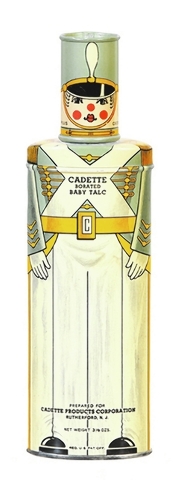Clubs, publications can provide information about collectibles
Hunting for treasures seems to be an inborn trait. Perhaps it’s from the need of the caveman to search, find food and store some for later use. For centuries, the very rich surrounded themselves with expensive art and artifacts to impress each other and “the peasants.”
Today, many people enjoy collecting a variety of things, like costume jewelry, bottles, tools, prints, pottery, 1950s furniture, advertising and sports and political items. Sometimes the best information about collections comes from the clubs and publications devoted to the subject.
One subcategory of advertising we recently noticed are talcum powder tins, since lawsuits related to talcum powder have been in the news recently. Talc is a mineral. It absorbs moisture, and in powdered form it has been used for centuries to keep skin dry. Some natural talc contains asbestos, which can be dangerous to health, so since the 1970s the talcum powder sold in stores has been processed to be asbestos-free.
Collectors like old talcum powder tins because of their clever designs made to attract buyers. Tins were decorated with images of babies, flowers, nursery-rhyme figures and clever graphics. Egyptian talcum powder made by Palmolive was in a tin that looks like an Egyptian column. Mennen’s early tins feature a seated baby that we are told was actually the brand owner’s child. A 1964 can of Beatles “Margo of Mayfair” talc has a drawing of the four Beatles.
Look for tins by Watkins, Colgate, Johnson, Caswell-Massey and other major brands, and also brands from other countries or long-gone companies. Prices range from $10 to about $150 for most tins offered online, but the rarest and most beautiful may cost as much at $800.
Q: About 40 years ago, I bought an oak lawyer’s rotary desk at auction. It was in awful condition, having been used in the office of a grain elevator for many years. I refinished it and used it as my office desk for many years. One side section of the desk swivels and the other side has a large drawer for files. Pasted inside one of the small drawers is a form for ordering accessory items from the E.H. Stafford Desk Co. of Muskegon, Mich. Any history?
A: The E.H. Stafford Co. was founded in 1890 and was reincorporated as E.H. Stafford Manufacturing Co. in 1904. The company made school, church and office furniture as well as opera chairs. It was in business until at least the 1920s. Because it’s an interesting desk, it probably would sell for $500 to $700.
Q: I’m trying to find information about my old copper barrel. It’s stamped “Lippincott, 8 gal.” and “916 Filbert St.” It also has an eagle on it and the abbreviation “Phila.” Can you tell me who made the barrel and how old it might be?
A: Several members of the Lippincott family ran a business at this Filbert Street address from 1832 until about 1911. John and Charles Lippincott of Philadelphia made special copper machinery before expanding into the production of soda water, syrups and equipment for carbonating water.
Charles took over the business from John, his older brother, in 1865. He made ornate soda fountains with multiple spigots for different flavors. Charles Lippincott &Co. joined with three other companies to form the American Soda Fountain Co., a trust designed to monopolize soda fountain manufacturing, in 1891.
When Charles retired, his sons A.H. and F.H. Lippincott took over the business. They withdrew from the American Soda Fountain Co. in 1907 and moved to a different address in about 1911. By 1916 the company was no longer making soda fountains. Your copper bucket was made before 1911.
Q: I have about 100 different-colored airplane cards that were packaged in Wings cigarettes during World War II. They picture U.S. and Royal Air Force warplanes with identification and other information on the back. The cards are 2 by 2½ inches. What are they worth?
A: Wings cigarettes were first made by Brown &Williamson Tobacco Corp. of Louisville, Ky., in 1929. The company sponsored a radio show called “Wings of Destiny” from 1940 to 1942, and the cards were issued as premiums in cigarette packs during those years. They are part of a series called “Modern American Airplanes.”
There were three sets of cards with 50 cards in each set. The company originally intended to issue just one set, but later decided to issue two more. The sets are labeled A, B or C, although not all of the first set had a letter code. Cards from the first set are harder to find than those from later sets. The cards, in good condition, sell for about $1 to $2 each today.
Q: I have a leather card case marked “Wilro Shop.” Can you tell me something about the maker and possible age of the case?
A: The Wilro Shop was founded in 1902 by sisters Rose and Minnie Dolese of Chicago. They made leather and metal goods, dower and wardrobe chests, pottery and other items. Tooled purses, card cases, desk sets and illuminated leather book covers were decorated in the Arts and Crafts style popular at the time.
Tip: Don’t ignore vintage transistor radios (1955-1963) if you see them at house sales or flea markets. Collector interest in all kinds of radios is growing and the supply of old radios is shrinking.
Terry Kovel’s column is syndicated by King Features. Write to: Kovels, (Las Vegas Review-Journal), King Features Syndicate, 300 W. 57th St., New York, NY 10019.


























